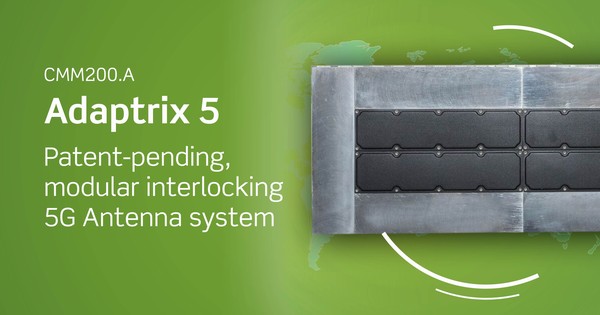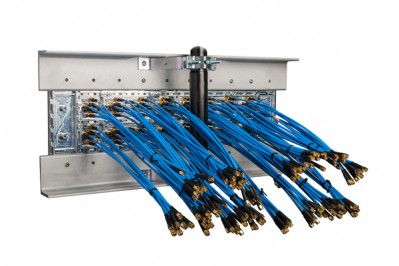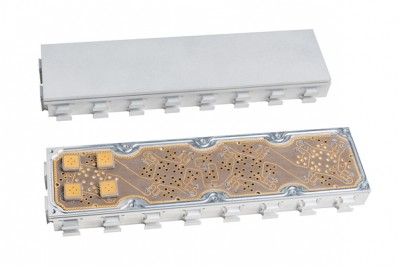
In a move to accelerate the launch of 5G wireless communications networks around the world, Taoglas, a leading provider of IoT and M2M antenna and RF solutions, unveiled its new series of 5G massive MIMO antenna arrays, designed to allow customers to provide the fastest and best user experiences for the next generation of wireless communications. The new antennas — including the Adaptrix CMM200.A, which features a patent-pending, modular interlocking system to help operators scale quickly to meet the speed and capacity demands of 5G — were demonstrated at Embedded World fair in Nuremberg, Germany.
Wireless industry pundits have dubbed 2017 the year of 5G, as ultra-high-speed networks begin to move out of the proof of concept stage and into the field. Designed to support the growing demand from IoT devices and users for high-speed, low-latency connectivity for a growing multitude of use cases across industries, 5G networks need to be able to scale quickly to support demand, with the flexibility to accommodate different spectrum requirements and use cases as they emerge.
5G demands best-in-class solutions from a quality and performance perspective, and antennas are the critical link. The 5G communications hardware market needs precision, quality and even more engineering support than ever before. Like in the race to 4G LTE, Taoglas is the first antenna vendor on the device side to provide 5G antenna solutions and options.
The new 5G antenna solutions from Taoglas include:
- Adaptrix CMM200.A, a5-6GHz C-Band Massive MIMO Array
- Aurora CMM100.A, a 5-6 GHz C-Band Massive MIMO Phased Array
- Pegasus CMM300.A, a 5-6GHz C-Band 2×8 Slant Polarised Massive MIMO Panel
- Sauron ELA100.A, a 77GHz E-Band Lens Array Antenna


The Adaptrix antenna is the first in a series of millimeter wave antenna arrays from Taoglas that demonstrates the company’s patent-pending interlocking modular system. Dermot O’Shea, co-CEO of Taoglas, said: “This first-in-the-industry antenna system means that when you need to add capacity, you simply attach extra panels. You can build them up vertically or horizontally like Lego blocks. You don’t need to worry about spacing, alignment or positioning, it’s a fool-proof system to achieving optimal installation methods.”
“As the 5G drum begins to beat more loudly, the market demand is growing for 5G antennas that can scale and adapt quickly as standards emerge,” said Ronan Quinlan, co-CEO of Taoglas. “Taoglas’ 5G antennas will help vendors and network operators not only get into the field with 5G technology more quickly, but simplify installation and reconfiguration, helping them rapidly adjust and scale as demand and other requirements grow”.
Aurora CMM.100.A 5-6GHz C-Band Massive MIMO Phased Array is designed for future 5G application where high gain directive beams will be needed to address the high-bandwidth demands of a fixed or mobile user.
The panel has over 1GHz 10dB impedance bandwidth and features over 20dB isolation between the horizontal and vertical polarizations.

The panel incorporates 64 antenna elements, each of which transmits and receives at different polarizations at the same time providing two independent signal paths from the transmitter to the receiver, resulting in a 128 antenna wireless system in just one panel.
Multiple panels can be merged together, using an innovative and simple click-in mechanism, to provide a Massive MIMO array offering limitless gain value.
In Massive MIMO Multiple beam can be individually steered to offer higher throughput and coverage while mitigating co-channel interference than legacy LTE antenna technology. In Multi-User Massive MIMO allows for up to 12 antennas used for 1 client device and 128 antennas can serve 10 clients simultaneously. The 5-6GHz Massive MIMO array combines 12 radiating elements at a time to give an effective gain of 19dBi with a half power beamwidth of 14° degrees. Alternatively all 128 antennas can be combined to give an effective gain of 27 dBi with a halfpower beamwidth of 7°.
The Massive MIMO technology enables beamforming to address multiple moving users at the same time which the Aurora also supports.
